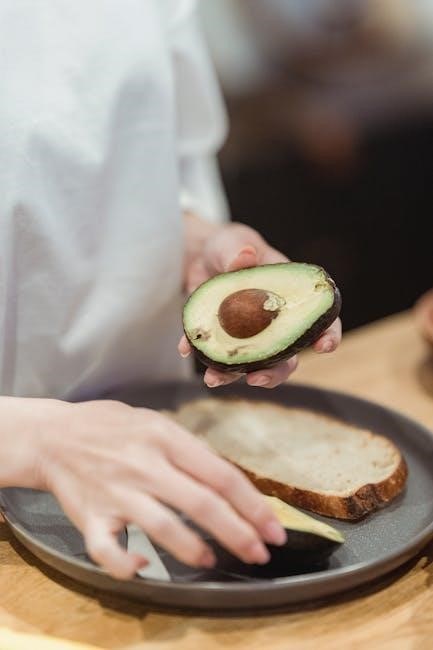Bread slicing guides provide convenience, precision, and efficiency for achieving uniform slices. They are essential tools for home bakers and professionals, ensuring clean cuts and consistent results.
What Are Bread Slicing Guides?
Bread slicing guides are tools designed to help cut loaves into uniform, even slices. They come in various forms, including manual and electric slicers, and DIY options. These guides ensure precision and consistency, making the process easier and cleaner. Many feature adjustable settings to control slice thickness, while others include crumb-catching trays for mess-free results. Whether for home use or professional settings, bread slicing guides are essential for achieving perfectly sliced bread every time, enhancing both presentation and portion control.
History of Bread Slicing
Bread slicing has evolved significantly over time, from manual cutting with knives to the use of advanced tools. Early methods involved simple knives, while modern techniques employ guides and electric slicers. The introduction of bread slicing guides and electric knives revolutionized the process, offering precision and ease. These tools became popular for their ability to produce uniform slices, making them ideal for both home and professional use. The development of specialized slicers, like the Norpro guide, further enhanced convenience and consistency. Today, bread slicing is a streamlined process, reflecting a blend of traditional methods and innovative technology.

Importance of Bread Slicing Guides
Bread slicing guides ensure uniform, clean cuts, making the process efficient and mess-free. They enhance convenience, portion control, and presentation, while keeping countertops clean during slicing sessions.
Convenience and Portion Control
Bread slicing guides offer unparalleled convenience by streamlining the slicing process, ensuring uniform thickness and minimizing crumbs. This tool is especially handy for portion control, allowing users to slice bread into consistent sizes for meals, snacks, or entertaining. The guides keep countertops clean by containing crumbs, making cleanup effortless. They are ideal for households needing precise portions, such as for sandwiches, toast, or dietary requirements. By providing a steady and organized way to slice, bread slicing guides enhance efficiency and reduce waste, making them a must-have for bakers and home cooks seeking to optimize their bread-slicing routine with ease and precision.
Achieving Uniform Slices
Achieving uniform slices is made effortless with bread slicing guides, which ensure consistency in thickness and appearance. These tools are designed to hold the loaf firmly, guiding the knife through even cuts. Whether slicing crusty, soft, or artisan bread, the guides prevent unevenness, resulting in professional-looking slices. This consistency is particularly valuable for presentations, sandwiches, and toast, where uniformity enhances both aesthetics and taste. By eliminating the guesswork of manual slicing, bread slicing guides empower users to achieve perfectly even slices every time, making them an indispensable tool for anyone seeking precision and perfection in their bread preparation and serving.
Enhancing Bread Presentation
Bread slicing guides play a crucial role in enhancing bread presentation by ensuring clean, even cuts that elevate the visual appeal of any dish. Uniform slices allow for attractive layering in sandwiches and neat arrangements on platters, making them ideal for gatherings and special occasions. The precision offered by these tools helps maintain the bread’s integrity, preventing tears or uneven edges that can detract from its appearance. Whether for a rustic artisan loaf or a delicate baguette, achieving consistent slices transforms bread into a centerpiece, adding a professional touch to both everyday meals and formal settings, and making every presentation look effortlessly polished and inviting.
Tools and Equipment for Bread Slicing
Bread slicing tools include manual slicers, electric knives, and machines, each designed for precision and efficiency, ensuring uniform slices and catering to various bread types and needs;
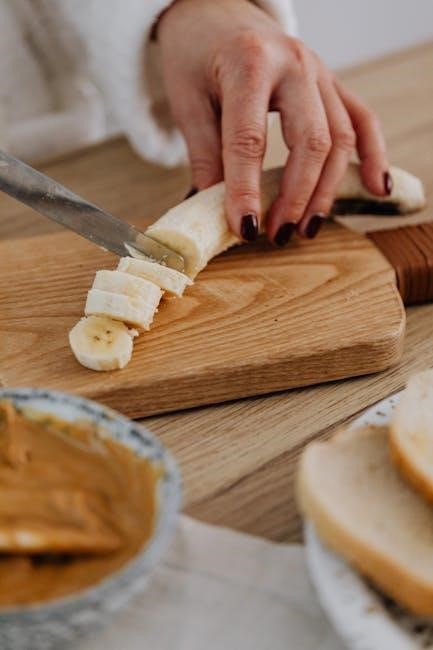
Manual Bread Slicers
Manual bread slicers are practical tools that ensure even, clean cuts without electricity. They often feature adjustable thickness settings and compact designs, making them ideal for home use. Durable materials like hardwood or stainless steel are commonly used, ensuring longevity. These slicers are easy to clean and store, perfect for small batches. Many users appreciate their simplicity and cost-effectiveness compared to electric models; Additionally, manual slicers allow for precise control, ideal for artisanal breads or softer loaves that might be tricky to slice with a knife alone. They are a popular choice among baking enthusiasts seeking consistency and convenience in their kitchen.
Electric Knives for Bread Slicing
Electric knives are efficient tools for slicing bread, offering ease and consistency. They are particularly effective for softer breads, which can be challenging to slice evenly with manual methods. Many electric knives come with adjustable thickness settings, allowing for customizable slices. Safety tips are crucial, as the blades are sharp and operate at high speeds. Regular maintenance, such as cleaning and sharpening, ensures optimal performance. Some models also include ergonomic handles for comfort during use. Electric knives are versatile and can be used for other foods like meats or vegetables, making them a practical addition to any kitchen. They provide a modern solution for precise bread slicing.
Bread Slicing Machines
Bread slicing machines automate the process of cutting loaves into uniform slices. They are ideal for high-volume use, such as in bakeries or restaurants. These machines typically feature adjustable blade settings and can handle various bread types, including crusty and soft varieties. Commercial-grade models often include safety features like automatic shut-off and blade guards to prevent accidents. Maintenance involves regular cleaning and sharpening of blades to ensure consistent performance. Some machines are compact for home use, while others are large-scale for industrial settings. Bread slicing machines offer precision and efficiency, making them a valuable investment for anyone needing consistent, high-quality bread slicing results. They streamline the process, saving time and effort.
Accessories for Bread Slicing
Accessories for bread slicing enhance the efficiency and cleanliness of the process. A popular accessory is the bread slicing guide, which attaches to the loaf or knife, ensuring even cuts. Crumb trays or catchers are also essential, keeping countertops clean by collecting crumbs during slicing. Some slicers come with adjustable thickness settings, allowing for customization. Additionally, knife sharpeners are valuable for maintaining sharp blades, while wooden or plastic cutting boards provide stable surfaces for slicing. For homemade solutions, DIY guides made from wood or plastic can be crafted to hold the loaf steady. These accessories improve precision, reduce mess, and make bread slicing more enjoyable and efficient for both professionals and home users.
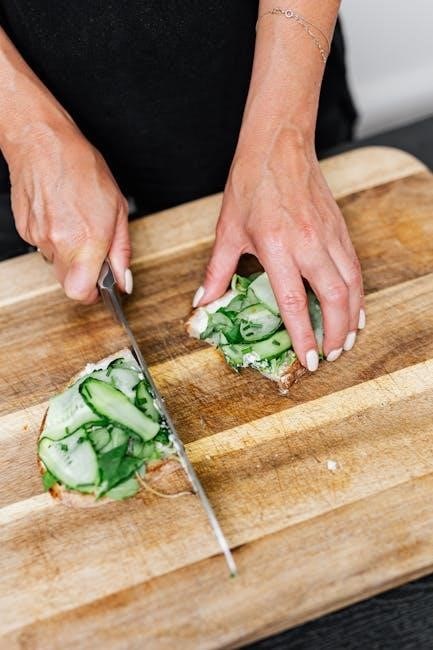
Techniques for Slicing Different Types of Bread
Various bread types require tailored slicing techniques. Crusty breads need a serrated knife, while soft breads benefit from gentle, even strokes. Adjusting knife angles ensures clean cuts.
Slicing Crusty Breads
Slicing crusty breads requires precision and care to maintain their texture. Use a serrated knife with a smooth, even motion, applying gentle pressure to avoid tearing. Start at the top and glide through the loaf, letting the weight of the knife do the work. For harder crusts, a sharp blade is essential to prevent crumbling. Place the bread on a stable surface and slice in a consistent direction to achieve uniform pieces. This method ensures the crust remains intact while yielding soft, even slices perfect for serving or toasting.
Slicing Soft Breads
Slicing soft breads requires a gentle touch to maintain their texture and avoid tearing. Use a sharp serrated knife or an electric knife, as they glide smoothly through the loaf. Apply light, even pressure, letting the knife do the work rather than pressing down heavily. Start at the top and slice in a steady, continuous motion. For very soft breads, consider using a bread slicing guide to help stabilize the loaf and achieve uniform slices. To minimize crumbs, slice when the bread is fresh but not straight from the oven. This ensures clean cuts and prevents the bread from compressing or tearing unnecessarily.
Slicing Artisan Breads
Slicing artisan breads requires precision and care to preserve their unique texture and structure. Use a sharp serrated knife or bread slicer to glide through the crust without tearing the interior. Start by stabilizing the loaf on a cutting board or slicing guide. Apply gentle, even pressure, using a smooth sawing motion to avoid compressing the bread. For crusty artisan loaves, let the knife do the work, maintaining control to achieve uniform thickness. This method ensures clean cuts while preserving the bread’s natural texture and presentation. A slicing guide can help maintain consistency, making it ideal for serving artisan breads neatly and professionally.
Slicing Gluten-Free Breads
Slicing gluten-free breads requires careful handling due to their delicate texture and tendency to crumble. Use a sharp serrated knife or electric slicer to minimize tearing. Place the loaf on a stable surface or slicing guide to maintain evenness. Apply gentle, consistent pressure, slicing in a smooth, steady motion. Avoid applying too much force, as this can cause the bread to break apart. For softer varieties, a serrated knife with a curved edge works well, while firmer gluten-free loaves may benefit from a straight-edge knife. A bread slicing guide can help achieve uniform thickness, ensuring clean, neat slices every time. This method preserves the bread’s texture and prevents crumbling, making it ideal for sandwiches or toast. Proper slicing enhances both presentation and usability, especially for gluten-free breads, which can be more challenging to handle than traditional varieties. By using the right tools and techniques, you can enjoy perfectly sliced gluten-free bread with ease.
Safety Tips for Bread Slicing
Always handle sharp tools with care, keep fingers away from blades, and store slicers securely. Ensure a clean, stable environment to prevent accidents during slicing.
Handling Sharp Objects Safely
Handling sharp objects safely is crucial to avoid injuries while slicing bread. Always use a stable cutting board and maintain a firm grip on the knife or slicer; Keep your fingers curled under and away from the blade. Never slice towards your body; instead, cut away to maintain control. Wearing cut-resistant gloves can add an extra layer of protection. Regularly inspect blades for dullness, as dull knives are more hazardous. Store sharp tools in a secure place, out of reach of children. Proper handling ensures a safe and efficient slicing experience for all users.
Preventing Accidents While Slicing
Preventing accidents while slicing requires attention to detail and adherence to safety guidelines. Always ensure the cutting surface is stable and free from clutter. Keep fingers away from the blade, using a serrated knife for better control; Maintain proper lighting to clearly see the bread and knife. Avoid slicing when distracted or in a hurry. Store sharp tools securely, out of children’s reach. Regularly check knives for dullness, as dull blades are more likely to slip. Use a bread slicing guide to maintain even pressure and alignment. Supervise children during slicing activities and teach them proper techniques. Safety precautions ensure a hazard-free experience.
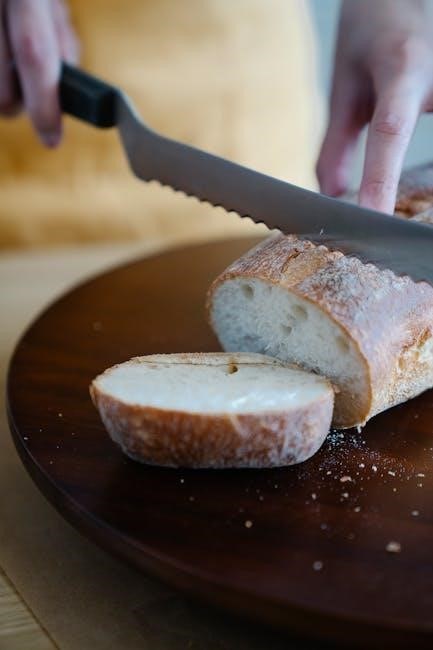
Safe Storage of Slicing Tools
Proper storage of slicing tools is crucial for maintaining safety and extending their lifespan. Always store knives and slicers in a dry, secure location, away from children’s reach. Use protective covers or sheaths to prevent accidental cuts and blade dulling. For electric slicers, unplug them after use and keep cords neatly stored. Avoid stacking tools on top of each other, as this can cause damage or create hazards; A designated storage area, such as a knife block or locked cabinet, is ideal. Regularly inspect tools for damage and ensure they are clean before storage. Safe storage practices prevent accidents and maintain tool efficiency.

Choosing the Right Bread Slicer
Selecting the right bread slicer involves considering ease of use, maintenance, and compatibility with your bread type. Manual slicers are ideal for softer breads, while electric models offer convenience for larger loaves.
Manual vs. Electric Slicers
Manual bread slicers offer precision and control, perfect for home bakers, while electric slicers provide speed and efficiency, ideal for large quantities. Manual slicers are cost-effective and easy to clean, but require effort. Electric slicers are convenient but may be bulky and more expensive. Both options ensure uniform slices, but the choice depends on personal preference and baking needs.
Features to Consider in a Slicer
When selecting a bread slicer, consider adjustable slice thickness, durability, and ease of cleaning. Look for models with sturdy materials, such as stainless steel or hardwood, to ensure longevity. Safety features, like secure grips or blade guards, are crucial to prevent accidents. Additionally, check for accessories like crumb-catching trays or ergonomic handles for added convenience. Some slicers also offer adjustable angle settings for precise cuts. For electric slicers, features like automatic shut-off or variable speed control can enhance performance. Prioritize your needs, whether it’s portability, versatility, or ease of use, to find the slicer that best fits your baking routine.
Budget-Friendly Options
Affordable bread slicing solutions are readily available, catering to all budgets. Manual slicers, like the Norpro bread slicing guide, offer precision at a low cost. Electric knives, while versatile, are also budget-friendly and effective for softer breads. For the crafty, DIY slicing guides made from wood and nails provide a cost-effective alternative. These options ensure consistent slices without breaking the bank, making professional-quality results accessible to everyone. They are ideal for home bakers seeking practicality and value, ensuring you can enjoy perfectly sliced bread without overspending.
DIY Bread Slicing Guide
Create a DIY bread slicing guide easily with basic materials. Use wood and nails to build a manual slicer for uniform slices. It is cost-effective and efficient.
Materials Needed for a DIY Guide

To create a DIY bread slicing guide, you’ll need hardwood (like maple), sandpaper, mineral oil, nails, and a saw. The wood ensures durability, while sandpaper smooths the surface. Mineral oil protects the wood and prevents bread from sticking. Nails secure the structure, and a saw helps cut the wood to size. Additional materials like a measuring tape and clamps aid in precise construction. These simple, affordable components allow you to craft a functional guide for uniform bread slices. Ensure all materials are food-safe for hygienic use.
Step-by-Step Construction Process
Start by cutting two identical hardwood boards to the desired size using a saw. Sand both boards for a smooth finish and apply mineral oil to protect the wood. Attach the boards together, ensuring alignment, and secure with nails. Create a slot along the top for the knife to glide through, maintaining even pressure. Add a compartment below to collect crumbs, keeping your countertop clean. Finally, test the guide with a loaf of bread to ensure it holds firmly and slices evenly. This process ensures a sturdy, functional guide tailored to your bread-slicing needs, promoting precision and convenience in the kitchen.
Tips for Using Your DIY Guide
For optimal results, place the DIY guide on a stable surface and secure the bread firmly. Use a sharp knife or electric knife for clean cuts, ensuring even pressure. Start slicing slowly, gliding the knife through the slot, and maintain consistent thickness for uniform slices. To prevent crumbs from spreading, utilize the built-in crumb compartment. Regularly clean the guide with a damp cloth and dry thoroughly to prevent moisture damage. For softer breads, consider using an electric knife, as it glides through effortlessly. Experiment with different angles for crusty or artisan breads to achieve desired results. This guide enhances your bread-slicing experience, making it both efficient and enjoyable.

Troubleshooting Common Issues
Address uneven slices by sharpening your knife or adjusting the guide. For crumbly bread, chill it first to minimize crumbling during slicing for cleaner results.
Dealing with Uneven Slices
Uneven slices can occur due to dull knives, improper technique, or uneven bread density. To address this, ensure your knife is sharp, as a dull blade often tears bread, leading to unevenness. Chill the bread in the refrigerator for about 30 minutes before slicing, as firmer bread holds its shape better and allows for more precise cuts. Additionally, use a bread slicing guide to maintain consistent thickness. For crusty bread, slice gently with a serrated knife, while softer bread may require a straight-edge knife. Regularly cleaning and sharpening your tools will also help achieve uniform results. Practice makes perfect!
Managing Crumbly Bread
Crumbly bread can be challenging to slice cleanly, but there are effective strategies to manage it. First, use a sharp serrated knife, as it helps minimize crumbling by sawing gently through the bread. Chilling the bread in the refrigerator for about 15 minutes firms it up, making it easier to handle. A bread slicing guide can also help maintain even pressure and alignment. For particularly crumbly bread, consider slicing it when it’s slightly stale, as fresh bread tends to crumble more. Additionally, using a gentle sawing motion rather than applying heavy pressure can reduce crumbling. Always slice on a stable surface for better control.

Maintenance and Care of Slicing Tools
Regular cleaning and sharpening of slicing tools ensure longevity. Use mild detergents and dry thoroughly to prevent rust. Apply oil to moving parts for smooth operation.
Cleaning Your Slicer
Cleaning your slicer is essential for maintaining hygiene and performance. For manual slicers, wipe blades with a damp cloth and mild detergent, then dry thoroughly to prevent rust. Electric slicers require unplugging before cleaning; use a soft brush to remove crumbs and a damp cloth for surfaces. Avoid abrasive cleaners or submerging electric parts in water. Regular sanitizing ensures food safety and prevents mold growth. Proper cleaning extends the lifespan of your slicer and ensures consistent slicing results. Always follow manufacturer guidelines for specific cleaning instructions.
Sharpening Your Slicing Tools
Sharpening your slicing tools is crucial for maintaining their effectiveness and ensuring clean, precise cuts. Dull blades can tear bread and lead to uneven slices. For manual slicers, use a whetstone or sharpening steel to hone the edge, following the manufacturer’s recommended angle. Electric slicers often have built-in sharpening features or detachable blades that can be professionally sharpened. Regular sharpening prevents crumbs from accumulating and improves slicing efficiency. Always sharpen away from your body and store sharp tools safely. Sharpening extends the lifespan of your slicer and ensures optimal performance. Follow specific guidelines for your tool to maintain its quality and functionality.
Advanced Slicing Techniques
Master advanced slicing methods for precision and artistry. Learn angled cuts, artistic presentation, and efficient handling of crusty, soft, and specialty breads for professional results.
Slicing for Special Diets
Slicing for special diets requires precision and care to meet specific nutritional needs. For gluten-free bread, use a sharp knife or electric slicer to avoid crumbling, ensuring even, thin slices. Low-carb or keto diets benefit from precise portion control, achieved with adjustable slicers. Always slice on a stable surface and store tools safely to prevent contamination. Using a bread slicing guide helps maintain consistency, crucial for dietary restrictions. These techniques make meal planning easier and more efficient, ensuring everyone can enjoy their favorite bread while adhering to their dietary preferences.
Artistic Bread Slicing
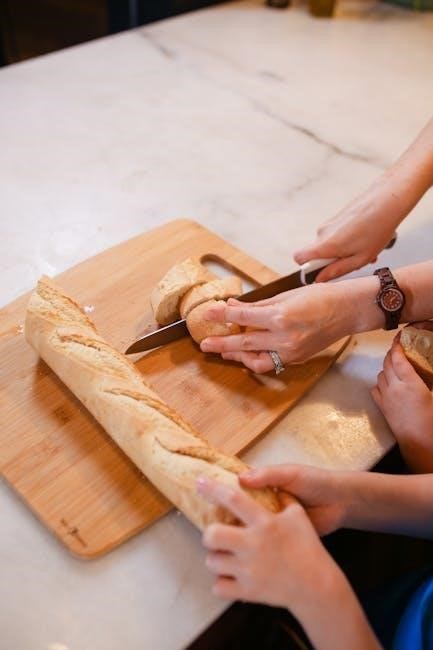
Artistic bread slicing transforms bread into a visually stunning element of any meal. By using precise techniques and sharp tools, you can create decorative slices that enhance presentation. For crusty breads, angled cuts reveal the interior texture, while soft breads can be carved into delicate patterns. Tools like serrated knives or electric slicers help achieve uniformity and precision. This method is perfect for special occasions or professional settings, where visual appeal matters. Experiment with different angles and thicknesses to add creativity to your bread servings, making every slice a masterpiece that complements the dish and delights the eye.
Slicing for Large Gatherings
Slicing bread for large gatherings requires efficiency and precision to ensure everyone is served quickly. Using tools like electric slicers or sharp knives can help achieve uniform slices in minimal time. For softer breads, an electric knife is ideal, while crusty breads may need a serrated blade. A bread slicing guide can help maintain consistency, even with high volumes. Pre-slicing and storing bread in covered containers keeps it fresh and ready for serving. This method is perfect for events, ensuring all guests enjoy perfectly sliced bread without delay, making it a practical solution for hosts aiming to impress and satisfy their audience.
Product Reviews and Recommendations
Top-rated slicers like the Norpro bread slicing guide offer precision and ease. Electric knives and machines are also highly recommended for consistent results and convenience in slicing bread evenly.
Top-Rated Manual Slicers
Manual slicers like the Norpro bread slicing guide are highly praised for their durability and ease of use. Designed with maple wood, they ensure clean, uniform slices every time. These guides are perfect for home bakers and professionals, offering precise control over slice thickness. Many models feature slats that allow crumbs to fall through, keeping countertops tidy. Their compact design makes them easy to store and clean. With sturdy construction, these slicers are a long-lasting addition to any kitchen. They are ideal for those who prefer traditional methods without relying on electricity. Top-rated manual slicers are a must-have for achieving consistent, professional-quality bread slices.
Best Electric Slicers on the Market
Electric slicers offer unparalleled convenience and speed for bread enthusiasts. Models like the Chef’sChoice and Cuisinart stand out for their powerful motors and adjustable slice thickness. These slicers are designed to handle both soft and crusty breads effortlessly. Features include automatic shutoff, safety locks, and easy-clean designs. They are ideal for large families or commercial use, providing consistent results with minimal effort. Reviews highlight their durability and versatility, making them a worthwhile investment for frequent bread slicing. For those seeking efficiency and precision, these electric slicers are top recommendations in the market.
Bread slicing guides offer unmatched convenience, ensuring uniform slices and effortless bread preparation. They are a valuable investment for both home bakers and professionals, enhancing efficiency and satisfaction.
Final Thoughts on Mastering Bread Slicing
Mastering bread slicing is a skill that enhances both convenience and presentation. By using the right tools and techniques, you can achieve perfectly uniform slices every time. Whether you’re a home baker or a professional, investing in a reliable bread slicing guide or slicer ensures consistency and ease. Additionally, understanding how to handle different types of bread, from crusty to gluten-free, allows for versatility in your slicing. With practice and the right equipment, you can elevate your bread slicing game, making every meal or gathering more enjoyable and visually appealing. Perfect slices are just a guide away!
